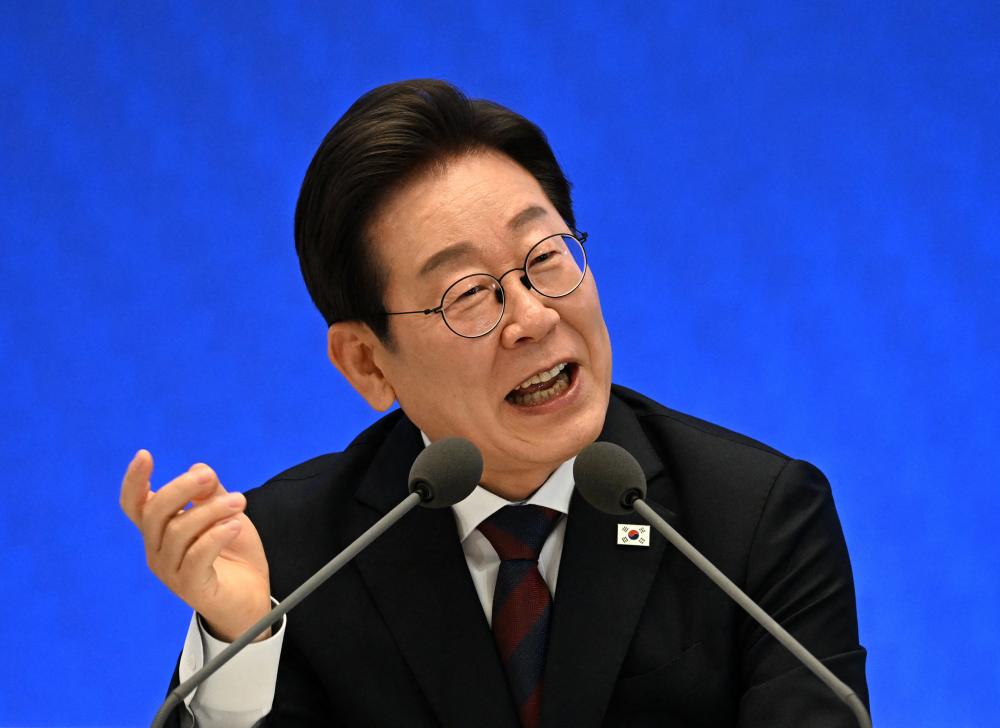By Raphael Rashid In Seoul
South Korea’s president, Lee Jae-myung, has given his first big press conference, a month after winning an election in a country shaken by a brief declaration of martial law imposed by his now-impeached predecessor, Yoon Suk Yeol.
Everything about the event seemed designed to signal a break from the defensive, isolated style of previous Yoon administration.
Here are five takeaways from the president’s two-hour appearance:
A different kind of leadership
Where his predecessor had shunned the media from a heavily fortified defence ministry compound, Lee chose the Blue House – the traditional presidential seat he plans to return to after renovations.
South Korea’s new president sat just one and a half metres from journalists, doing away with the raised podium and imperial trappings that had defined his predecessor’s rare public appearances.
During question time, reporters’ names were drawn from lottery boxes, giving tiny regional outlets the same chance as big networks to question the leader. His answers meandered for minutes, peppered with personal anecdotes and laughs.
Journalists were told in advance that the format was deliberately chosen to remove any sense of grandeur or power hierarchy.
Building bridges after martial law chaos
Lee was swept into the presidency after Yoon’s ill-fated martial law attempt, which triggered what Lee called a “national crisis” and badly shook public faith in government. Lee did not mention Yoon’s name once throughout the two-hour session.
Lee repeatedly emphasised cooperation across party lines to restore economic stability rather than continuing the polarisation so characteristic of Korean politics. He mentioned fears of secret recordings during unofficial meetings with the opposition, so deep was the distrust between sides.
When asked about concerns over weak oversight given that his party controls both the presidency and the national assembly with a supermajority, Lee acknowledged the political reality. “This is precisely the people’s choice,” he said.
‘Very difficult’ talks ahead on Trump tariffs
With the US tariff suspension to expire on 9 July, Lee was candid about the challenges ahead. “The tariff negotiations are very difficult, that’s certain,” he said. “We need to create mutually beneficial, truly reciprocal results, but so far both sides haven’t clearly sorted out exactly what they want.”
He admitted: “I cannot guarantee we can finish by the 8th.”
South Korea’s automotive sector, which exported $34.7bn (£25.4bn) worth of vehicles to the US last year, faces one of the biggest threats from potential 25% tariffs, while steel already faces 50%. The country’s lucrative semiconductor industry is also vulnerable.
Diplomacy and deterrence on North Korea
Drawing on his experience as a lawyer who handled marital conflicts, he compared inter-Korean relations to feuding couples whose problems had spiralled out of control. His solution? “I used to tell them to try switching roles. Usually people who did this came to understand each other.
“Misunderstanding breeds misunderstanding, conflict breeds conflict, distrust breeds distrust, hatred breeds hatred, so what was originally a small difference becomes unmanageable.
“Even during war, diplomacy continues,” Lee said. “Completely cutting off dialogue is really foolish.” But Lee also emphasised maintaining strong defence, promising continued military modernisation within the South Korea-US alliance framework.
He spoke of creating a “virtuous cycle of peace”, citing how North Korea quickly responded when Seoul halted cross-border loudspeaker broadcasts, but offered few specifics about how to achieve this when pressed.
Cutting the working week
When discussing plans to reduce South Korea’s working week to 4.5 days, he recalled his childhood working in a factory during dire poverty: “Initially we didn’t rest at all for a whole month. Then they let us rest once a month … then twice a month … then once a week.” Such changes take time, he suggested when asked when the plans could realistically be implemented.
